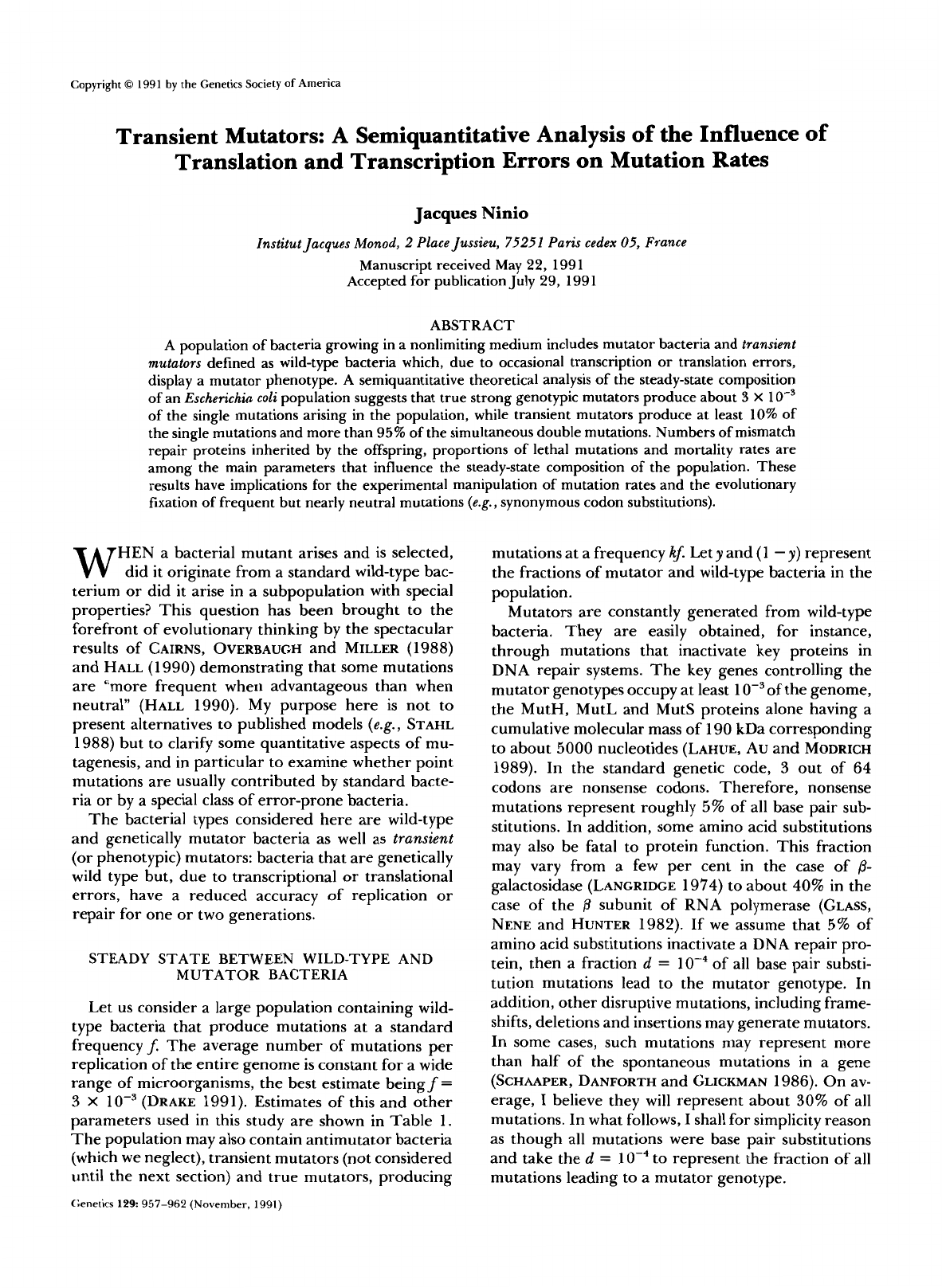
Copyright
0
1991
by the Genetics Society
of
America
Transient Mutators:
A
Semiquantitative Analysis
of
the Influence
of
Translation and Transcription Errors on Mutation Rates
Jacques
Ninio
Institut Jacques Monod, 2 Place Jussieu, 75251 Paris cedex 05, France
Manuscript received May
22,
199
1
Accepted for publication
July
29, 1991
ABSTRACT
A
population
of
bacteria growing
in
a
nonlimiting medium includes mutator bacteria and
transient
mututors
defined
as
wild-type bacteria which, due
to
occasional transcription or translation errors,
display
a
mutator phenotype.
A
semiquantitative theoretical analysis of the steady-state composition
of
an
Escherichia coli
population suggests that true strong genotypic mutators produce about
3
X
lo-’
of the single mutations arising in the population, while transient mutators produce
at
least
10%
of
the single mutations and more than 95% of the simultaneous double mutations. Numbers of
mismatch
repair proteins inherited by
the
offspring, proportions of lethal mutations and mortality rates are
among the main parameters
that
influence the steady-state composition
of
the population. These
results
have implications for the experimental manipulation
of
mutation rates and
the
evolutionary
fixation
of
frequent but nearly neutral mutations
(e.g.,
synonymous codon substitutions).
W
HEN a bacterial mutant arises and is selected,
did it originate from a standard wild-type bac-
terium
or
did it arise in a subpopulation with special
properties? This question has been brought to the
forefront of evolutionary thinking by the spectacular
results of CAIRNS,
OVERBAUGH
and MILLER
(1988)
and HALL
(1
990)
demonstrating that some mutations
are “more frequent when advantageous than when
neutral” (HALL
1990).
My purpose here is not to
present alternatives to published models
(e.g.,
STAHL
1988)
but to clarify some quantitative aspects of mu-
tagenesis, and in particular to examine whether point
mutations are usually contributed by standard bacte-
ria
or
by a special class of error-prone bacteria.
The bacterial types considered here are wild-type
and genetically mutator bacteria as
well
as
transient
(or
phenotypic) mutators: bacteria that are genetically
wild type but,
due
to transcriptional
or
translational
errors, have a reduced accuracy of replication or
repair for one or two generations.
STEADY STATE BETWEEN WILD-TYPE
AND
MUTATOR BACTERIA
Let us consider a large population containing wild-
type bacteria that produce mutations at
a
standard
frequency
f.
The average number of mutations
per
replication of the entire genome is constant for a wide
range of microorganisms, the best estimate beingf=
3
X
1
0-’
(DRAKE
1991).
Estimates of this and other
parameters used in this study are shown in Table
1.
The population may also contain antimutator bacteria
(which
we
neglect), transient mutators (not considered
until the next section) and true mutators, producing
Genetics
129
957-962
(November,
1991)
mutations at a frequency
kf.
Let
y
and
(1
-
y)
represent
the fractions of mutator and wild-type bacteria in the
population.
Mutators are constantly generated from wild-type
bacteria. They are easily obtained, for instance,
through mutations that inactivate
key
proteins in
DNA repair systems. The
key
genes controlling the
mutator genotypes occupy at least
1
0-’
of the genome,
the MutH, MutL and MutS proteins alone having a
cumulative molecular mass of
190
kDa corresponding
to about
5000
nucleotides (LAHUE, AU and
MODRICH
1989).
In the standard genetic code,
3
out of
64
codons are nonsense codons. Therefore, nonsense
mutations represent roughly
5%
of all base pair sub-
stitutions. In addition, some amino acid substitutions
may also be fatal to protein function. This fraction
may vary from a few per cent in the case of
p-
galactosidase (LANGRIDGE
1974)
to about
40%
in the
case of the
P
subunit of RNA polymerase (GLASS,
NENE and HUNTER
1982).
If
we
assume that
5%
of
amino acid substitutions inactivate a DNA repair
pro-
tein, then a fraction
d
=
of
all base pair substi-
tution mutations lead to the mutator genotype. In
addition, other disruptive mutations, including frame-
shifts, deletions and insertions may generate mutators.
In some cases, such mutations may represent more
than half of the spontaneous mutations in a gene
(SCHAAPER, DANFORTH and GLICKMAN
1986).
On av-
erage, I believe they will represent about
30%
of all
mutations. In what follows, I shall for simplicity reason
as though all mutations
were
base pair substitutions
and take the
d
=
to represent the fraction
of
all
mutations leading to a mutator genotype.
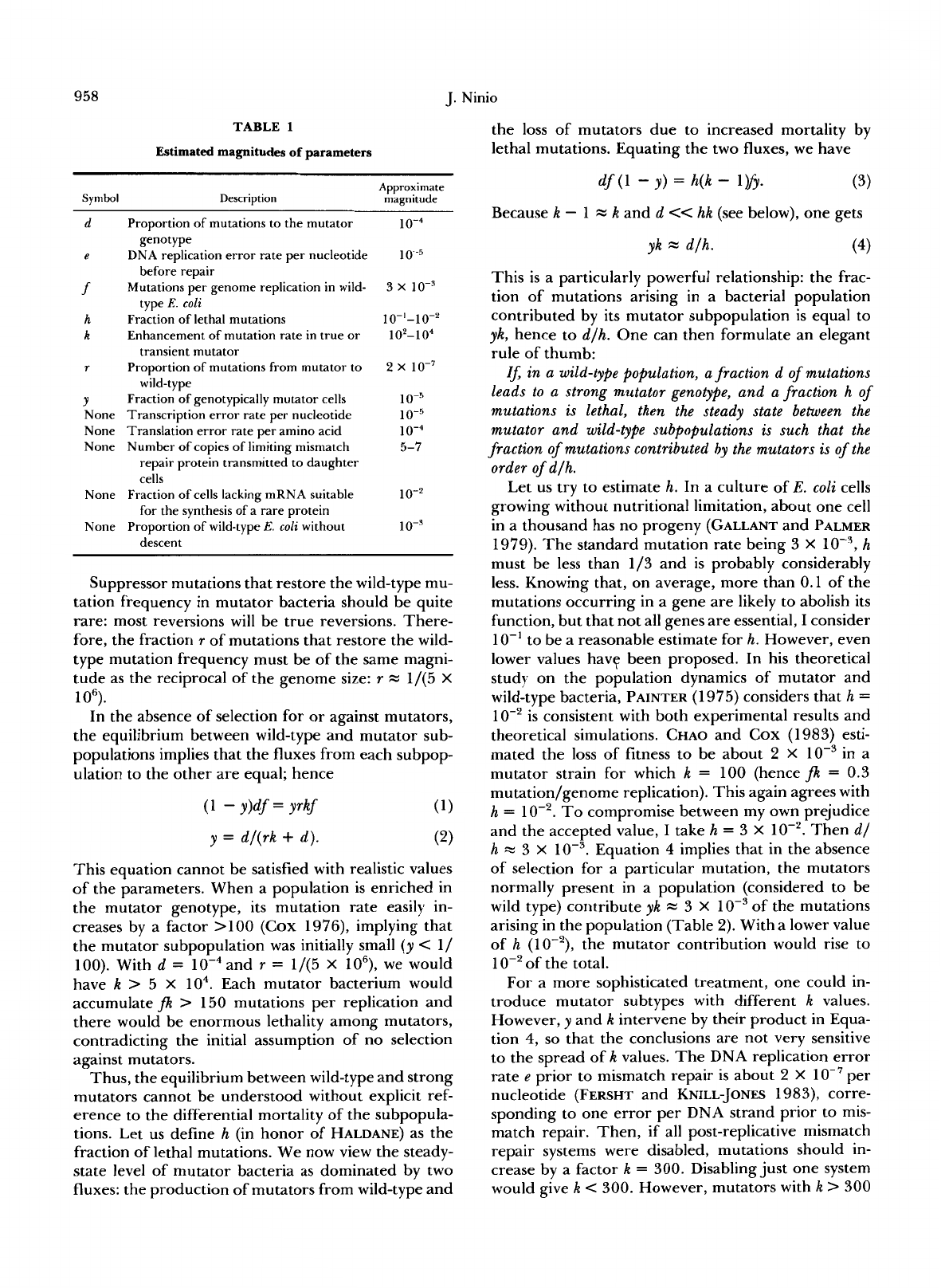
958
J.
Ninio
TABLE
1
Estimated magnitudes
of
parameters
Approximate
Symbol Description magnitude
d
Proportion
of
mutations to the mutator
1
o-~
e
DNA replication error rate per nucleotide
f
Mutations per genome replication in wild-
3
X
lo-'
h
Fraction of lethal mutations
10-"10-2
k
Enhancement
of
mutation rate in true or
102-104
r
Proportion of mutations from mutator to
2
X
10"
y
Fraction
of
genotypically mutator cells
1
o-5
None Transcription error rate per nucleotide
1
o-5
None Translation error rate per amino acid
10-4
None Number
of
copies
of
limiting mismatch
5-7
repair protein transmitted to daughter
cells
for the synthesis of a rare protein
descent
genotype
before repair
type
E.
coli
transient mutator
wild-type
None Fraction
of
cells lacking mRNA suitable
1
o+
None Proportion of wild-type
E.
coli
without
1
0-3
Suppressor mutations that restore the wild-type mu-
tation frequency in mutator bacteria should be quite
rare: most reversions
will
be true reversions. There-
fore, the fraction
r
of mutations that restore the wild-
type mutation frequency must be of the same magni-
tude as the reciprocal of the genome size:
r
1/(5
X
In the absence of selection for or against mutators,
the equilibrium between wild-type and mutator sub-
populations implies that the fluxes from each subpop-
ulation to the other are equal; hence
10".
(1
-
Y)df
=
yrkf
(1)
y
=
d/(rk
+
d).
(2)
This equation cannot be satisfied with realistic values
of
the parameters. When a population is enriched in
the mutator genotype, its mutation rate easily in-
creases by a factor >lo0 (Cox 1976), implying that
the mutator subpopulation was initially small
(y
<
1/
100). With
d
=
10-4and
r
=
1/(5
X
lo6),
we would
have
k
>
5
X
lo4. Each mutator bacterium would
accumulate
jk
>
150 mutations per replication and
there would be enormous lethality among mutators,
contradicting the initial assumption of no selection
against mutators.
Thus, the equilibrium between wild-type and strong
mutators cannot be understood without explicit ref-
erence to the differential mortality of the subpopula-
tions. Let
us
define
h
(in honor of HALDANE) as the
fraction of lethal mutations. We now view the steady-
state level of mutator bacteria as dominated by two
fluxes: the production
of
mutators from wild-type and
the loss of mutators due to increased mortality by
lethal mutations. Equating the two fluxes,
we
have
df
(1
-
y)
=
h(k
-
lfi.
(3)
Because
k
-
1
=
k
and
d
<<
hk
(see below), one gets
yk
=
d/h.
(4)
This is a particularly powerful relationship: the frac-
tion of mutations arising in a bacterial population
contributed by its mutator subpopulation is equal to
yk,
hence to
d/h.
One can then formulate an elegant
rule of thumb:
If;
in a wild-type population,
a
fraction d
of
mutations
leads to a strong mutator genotype, and a fraction h
of
mutations
is
lethal, then the steady state between the
mutator and wild-type subpopulations is such that the
fraction
of
mutations contributed by the mutators is
of
the
order
of
d/h.
Let
us
try to estimate
h.
In a culture of
E.
coli
cells
growing without nutritional limitation, about one cell
in a thousand has no progeny (GALLANT and PALMER
1979). The standard mutation rate being 3
X
h
must be less than 1/3 and is probably considerably
less. Knowing that, on average, more than 0.1
of
the
mutations occurring in a gene are likely to abolish its
function, but that not all genes are essential, I consider
10" to be a reasonable estimate for
h.
However, even
lower values have been proposed. In his theoretical
study on the population dynamics of mutator and
wild-type bacteria, PAINTER (1 975) considers that
h
=
is consistent with both experimental results and
theoretical simulations. CHAO and COX (1983) esti-
mated the loss of fitness to be about
2
X
lo-'
in a
mutator strain for which
k
=
100 (hence
jk
=
0.3
mutation/genome replication). This again agrees with
h
=
1
O-2.
To compromise between my own prejudice
and the accepted value, I take
h
=
3
X
Then
d/
h
=
3
X
lo-'.
Equation
4
implies that in the absence
of selection for a particular mutation, the mutators
normally present in a population (considered to be
wild
type) contribute
yk
=
3
x
of the mutations
arising in the population (Table
2).
With a lower value
of
h
(lo"), the mutator contribution would rise to
1
0-'
of the total.
For a more sophisticated treatment, one could in-
troduce mutator subtypes with different
k
values.
However,
y
and
k
intervene by their product in Equa-
tion
4,
so
that the conclusions are not very sensitive
to the spread
of
k
values. The DNA replication error
rate
e
prior to mismatch repair is about
2
X
10" per
nucleotide (FERSHT and KNILL-JONES 1983), corre-
sponding
to
one error per
DNA
strand prior to mis-
match repair. Then,
if
all post-replicative mismatch
repair systems were disabled, mutations should in-
crease by a factor
k
=
300. Disabling just one system
would give
k
<
300. However, mutators with
k
>
300
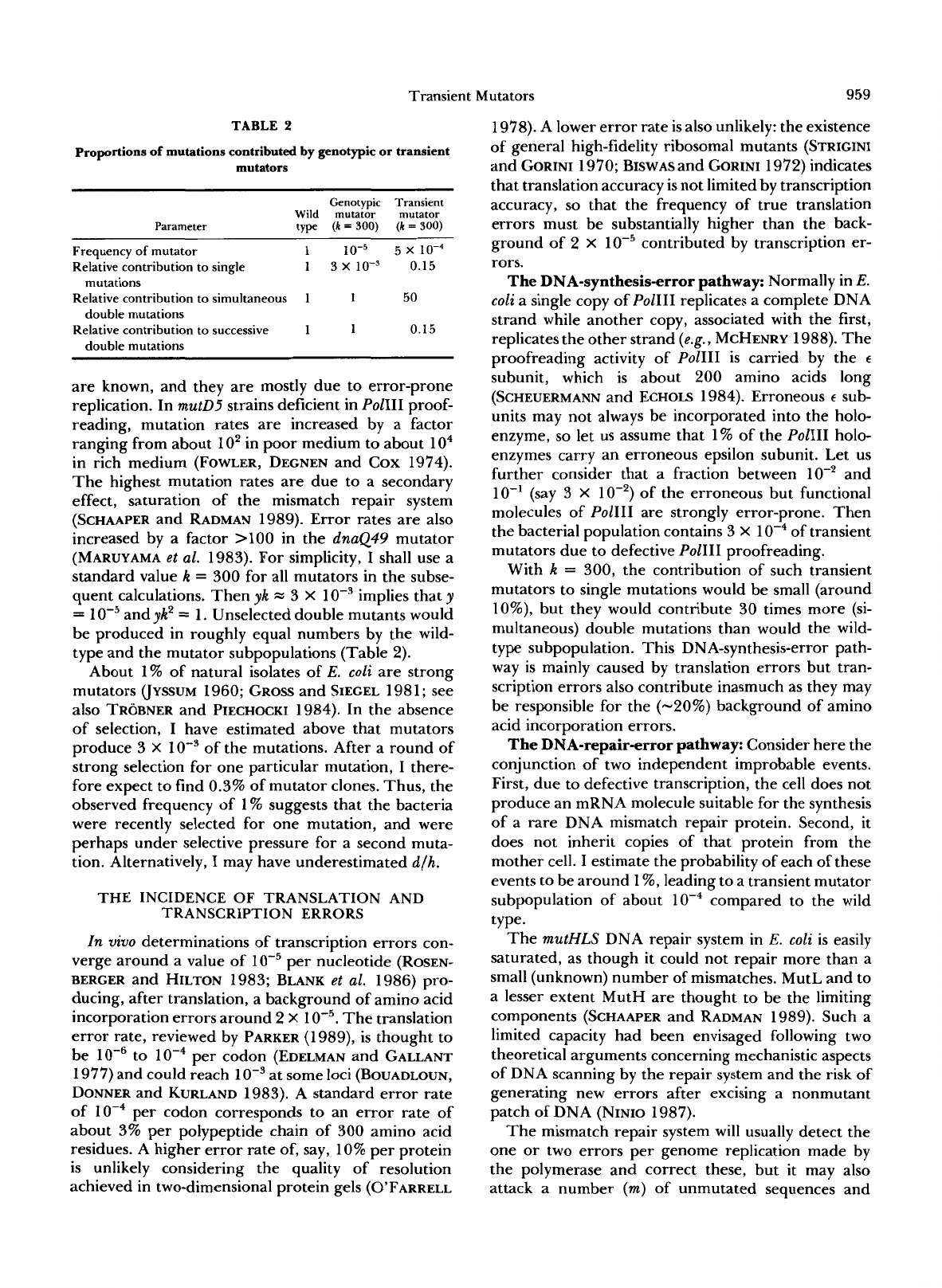
Transient
Mutators
959
TABLE
2
Proportions
of
mutations contributed by genotypic
or
transient
mutators
Genotypic Transient
Wild
mutator mutator
type
(k
=
300)
(k
=
300)
Parameter
Frequency
of
mutator
1
5
X
Relative contribution to single
1
3
X
lo-'
0.15
Relative contribution to simultaneous
1
1
50
Relative contribution to successive
1
1
0.15
mutations
double mutations
double mutations
are known, and they are mostly due to error-prone
replication.
In
mutD5
strains deficient in
Pol111
proof-
reading, mutation rates are increased by a factor
ranging from about
lo2
in poor medium to about
lo4
in rich medium (FOWLER, DEGNEN and Cox 1974).
The highest mutation rates are due to a secondary
effect, saturation of the mismatch repair system
(SCHAAPER and RADMAN 1989). Error rates are also
increased by a factor >lo0 in the
dnaQ49
mutator
(MARUYAMA
et
al.
1983). For simplicity,
1
shall use a
standard value
k
=
300 for all mutators in the subse-
quent calculations. Then
yk
3
X
lo-'
implies that
y
=
1
0-5
and
yk2
=
1. Unselected double mutants would
be
produced in roughly equal numbers by the
wild-
type and the mutator subpopulations (Table 2).
About 1%
of
natural isolates of
E.
coli
are strong
mutators
UYSSUM
1960; GROSS and SIEGEL 1981
;
see
also
TROBNER
and PIECHOCKI 1984). In the absence
of selection,
I
have estimated above that mutators
produce 3
X
lo-'
of the mutations. After a round of
strong selection for one particular mutation,
I
there-
fore expect to find
0.3%
of mutator clones. Thus, the
observed frequency
of
1% suggests that the bacteria
were recently selected
for
one mutation, and
were
perhaps under selective pressure for a second muta-
tion. Alternatively,
I
may have underestimated
d/h.
THE INCIDENCE
OF
TRANSLATION
AND
TRANSCRIPTION ERRORS
In
vivo
determinations of transcription errors con-
verge around a value of per nucleotide (ROSEN-
BERGER
and HILTON 1983; BLANK
et
al.
1986) pro-
ducing, after translation, a background of amino acid
incorporation errors around 2
X
I
OW5.
The translation
error rate, reviewed by PARKER (1989), is thought to
be
to per codon (EDELMAN and GALLANT
1977) and could reach
lo-'
at some loci (BOUADLOUN,
DONNER and
KURLAND
1983). A standard error rate
of per codon corresponds to an error rate of
about
3%
per polypeptide chain of
300
amino acid
residues. A higher error rate
of,
say, 10% per protein
is unlikely considering the quality of resolution
achieved in two-dimensional protein gels (O'FARRELL
1978). A
lower
error rate is also unlikely: the existence
of general high-fidelity ribosomal mutants (STRIGINI
and
GORINI
1970; BISWAS and GORINI 1972) indicates
that translation accuracy is not limited
by
transcription
accuracy,
so
that the frequency of true translation
errors must be substantially higher than the back-
ground of 2
X
contributed by transcription
er-
rors.
The DNA-synthesis-error pathway:
Normally in
E.
coli
a single copy of
PolIII
replicates a complete DNA
strand while another copy, associated with the first,
replicates the other strand
(e.g.,
MCHENRY 1988). The
proofreading activity of
PolIII
is carried by the
E
subunit, which is about 200 amino acids long
(SCHEUERMANN and ECHOLS 1984). Erroneous
E
sub-
units may not always be incorporated into the holo-
enzyme,
so
let us assume that 1%
of
the
PolIII
holo-
enzymes carry an erroneous epsilon subunit. Let us
further consider that a fraction between lo-* and
10" (say 3
X
1
O-')
of the erroneous but functional
molecules of
Pol111
are strongly error-prone. Then
the bacterial population contains 3
X
1
0-4
of transient
mutators due to defective
PolIII
proofreading.
With
k
=
300, the contribution of such transient
mutators to single mutations would be small (around
lo%), but they would contribute
30
times more (si-
multaneous) double mutations than would the
wild-
type subpopulation. This DNA-synthesis-error path-
way is mainly caused by translation errors but tran-
scription errors also contribute inasmuch as they may
be responsible for the
(-20%)
background of amino
acid incorporation errors.
The DNA-repair-error pathway:
Consider here the
conjunction of two independent improbable events.
First, due to defective transcription, the cell does not
produce an mRNA molecule suitable for the synthesis
of
a rare DNA mismatch repair protein. Second, it
does not inherit copies of that protein from the
mother cell.
I
estimate the probability of each of these
events to be around 1
%,
leading to a transient mutator
subpopulation of about compared to the
wild
tY
Pee
The
mutHLS
DNA repair system in
E.
coli
is easily
saturated, as though it could not repair more than a
small (unknown) number of mismatches. MutL and to
a lesser extent MutH are thought to be the limiting
components (SCHAAPER and RADMAN 1989). Such a
limited capacity had been envisaged following two
theoretical arguments concerning mechanistic aspects
of
DNA scanning by the repair system and the risk
of
generating new errors after excising a nonmutant
patch of DNA (NINIO 1987).
The mismatch repair system will usually detect the
one
or
two
errors per genome replication made by
the polymerase and correct these, but it may also
attack a number
(m)
of
unmutated sequences and
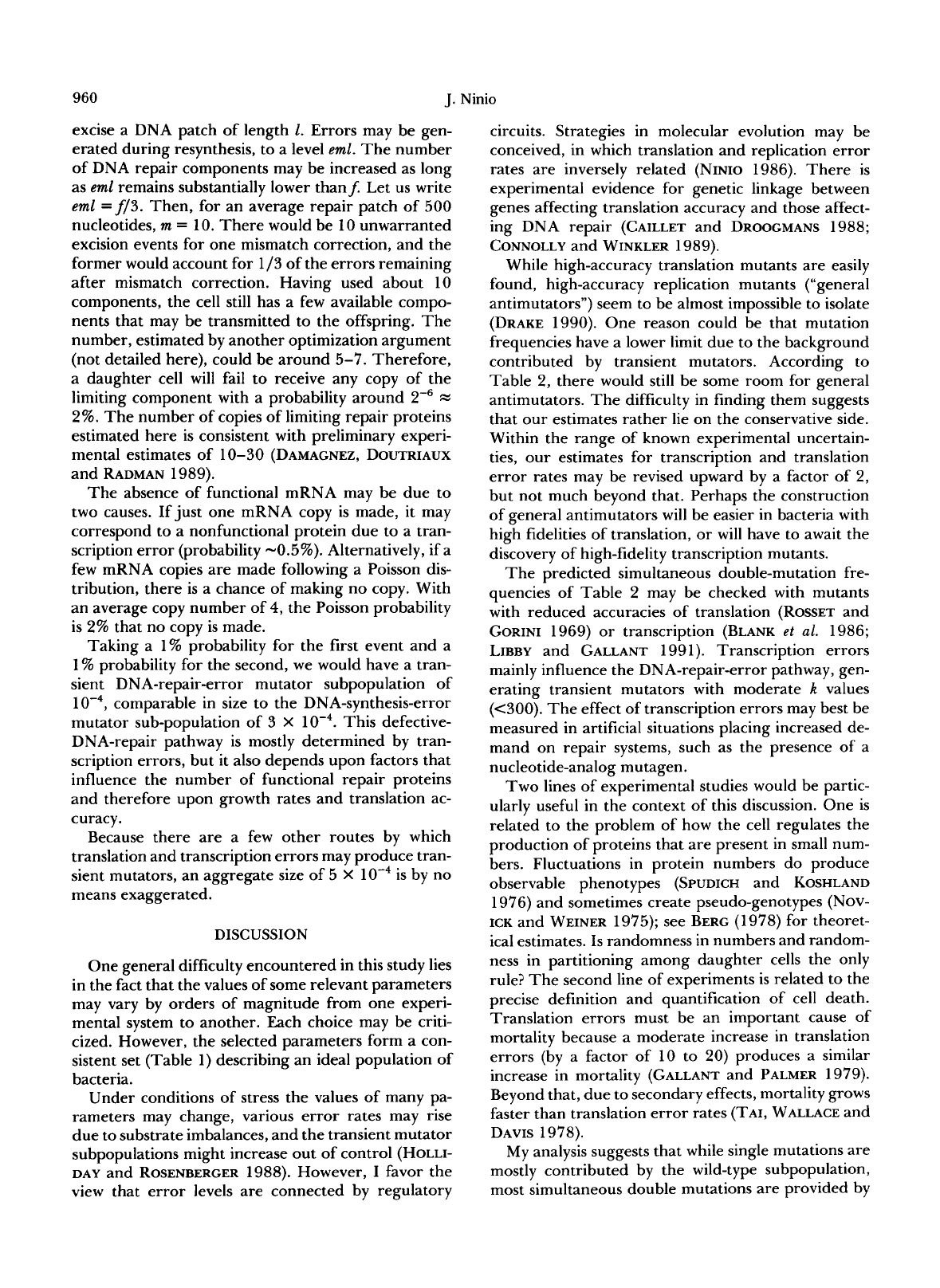
960
J.
Ninio
excise a DNA patch of length
1.
Errors may be gen-
erated during resynthesis, to a
level
eml.
The number
of DNA repair components may be increased as long
as
eml
remains substantially lower thanf. Let us write
em1
=
f/3. Then, for an average repair patch of 500
nucleotides,
m
=
10. There would be 10 unwarranted
excision events for one mismatch correction, and the
former would account for 1/3 of the errors remaining
after mismatch correction. Having used about 10
components, the cell still has a few available compo-
nents that may be transmitted to the offspring. The
number, estimated by another optimization argument
(not detailed here), could be around 5-7. Therefore,
a daughter cell
will
fail to receive any copy of the
limiting component with a probability around
2-6
=
2%.
The number of copies of limiting repair proteins
estimated here is consistent with preliminary experi-
mental estimates of 10-30 (DAMAGNEZ, DOUTRIAUX
and RADMAN 1989).
The absence of functional mRNA may
be
due to
two causes. If just one mRNA copy is made, it may
correspond to a nonfunctional protein due to a tran-
scription error (probability -0.5%). Alternatively, if a
few mRNA copies are made following a Poisson dis-
tribution, there is a chance of making no copy. With
an average copy number of
4,
the Poisson probability
is
2%
that no copy is made.
Taking a 1% probability for the first event and a
1%
probability for the second,
we
would have a tran-
sient DNA-repair-error mutator subpopulation of
comparable in size to the DNA-synthesis-error
mutator sub-population of 3
X
This defective-
DNA-repair pathway is mostly determined by tran-
scription errors, but it also depends upon factors that
influence the number of functional repair proteins
and therefore upon growth rates and translation ac-
curacy.
Because there are a few other routes by which
translation and transcription errors may produce tran-
sient mutators, an aggregate size of 5
x
is by no
means exaggerated.
DISCUSSION
One general difficulty encountered in this study lies
in the fact that the values of some relevant parameters
may vary by orders of magnitude from one experi-
mental system to another. Each choice may be criti-
cized. However, the selected parameters form a con-
sistent set (Table 1) describing an ideal population of
bacteria.
Under conditions of stress the values of many pa-
rameters may change, various
error
rates may rise
due to substrate imbalances, and the transient mutator
subpopulations might increase out of control (HOLLI-
DAY
and ROSENBERGER 1988). However,
I
favor the
view that error levels are connected
by
regulatory
circuits. Strategies in molecular evolution may be
conceived, in which translation and replication error
rates are inversely related (NINIO 1986). There is
experimental evidence for genetic linkage between
genes affecting translation accuracy and those affect-
ing DNA repair (CAILLET and DROOGMANS 1988;
CONNOLLY and WINKLER 1989).
While high-accuracy translation mutants are easily
found, high-accuracy replication mutants (“general
antimutators”) seem to be almost impossible to isolate
(DRAKE 1990). One reason could be that mutation
frequencies have a lower limit due to the background
contributed
by
transient mutators. According
to
Table
2,
there would still be some room for general
antimutators. The difficulty in finding them suggests
that our estimates rather lie on the conservative side.
Within the range of known experimental uncertain-
ties, our estimates for transcription and translation
error rates may
be
revised upward by a factor of
2,
but not much beyond that. Perhaps the construction
of general antimutators
will
be easier in bacteria with
high fidelities of translation, or
will
have to await the
discovery of high-fidelity transcription mutants.
The predicted simultaneous double-mutation fre-
quencies of Table
2
may be checked with mutants
with reduced accuracies of translation (ROSSET and
GORINI 1969) or transcription (BLANK
et
al.
1986;
LIBBY and GALLANT 1991). Transcription errors
mainly influence the DNA-repair-error pathway, gen-
erating transient mutators with moderate
K
values
(<300). The effect of transcription errors may best be
measured in artificial situations placing increased de-
mand on repair systems, such as the presence of a
nucleotide-analog mutagen.
Two lines of experimental studies would be partic-
ularly useful in the context of this discussion. One is
related to the problem of how the cell regulates the
production of proteins that are present in small num-
bers. Fluctuations in protein numbers do produce
observable phenotypes (SPUDICH and
KOSHLAND
1976) and sometimes create pseudo-genotypes (NOV-
ICK
and WEINER 1975); see BERG (1978) for theoret-
ical estimates.
Is
randomness in numbers and random-
ness in partitioning among daughter cells the only
rule? The second line of experiments is related to the
precise definition and quantification of cell death.
Translation errors must be an important cause
of
mortality because a moderate increase in translation
errors (by a factor of 10 to
20)
produces a similar
increase in mortality (GALLANT and PALMER 1979).
Beyond that, due to secondary effects, mortality grows
faster than translation error rates
(TAI,
WALLACE and
DAVIS 1978).
My
analysis suggests that while single mutations are
mostly contributed by the wild-type subpopulation,
most simultaneous double mutations are provided by
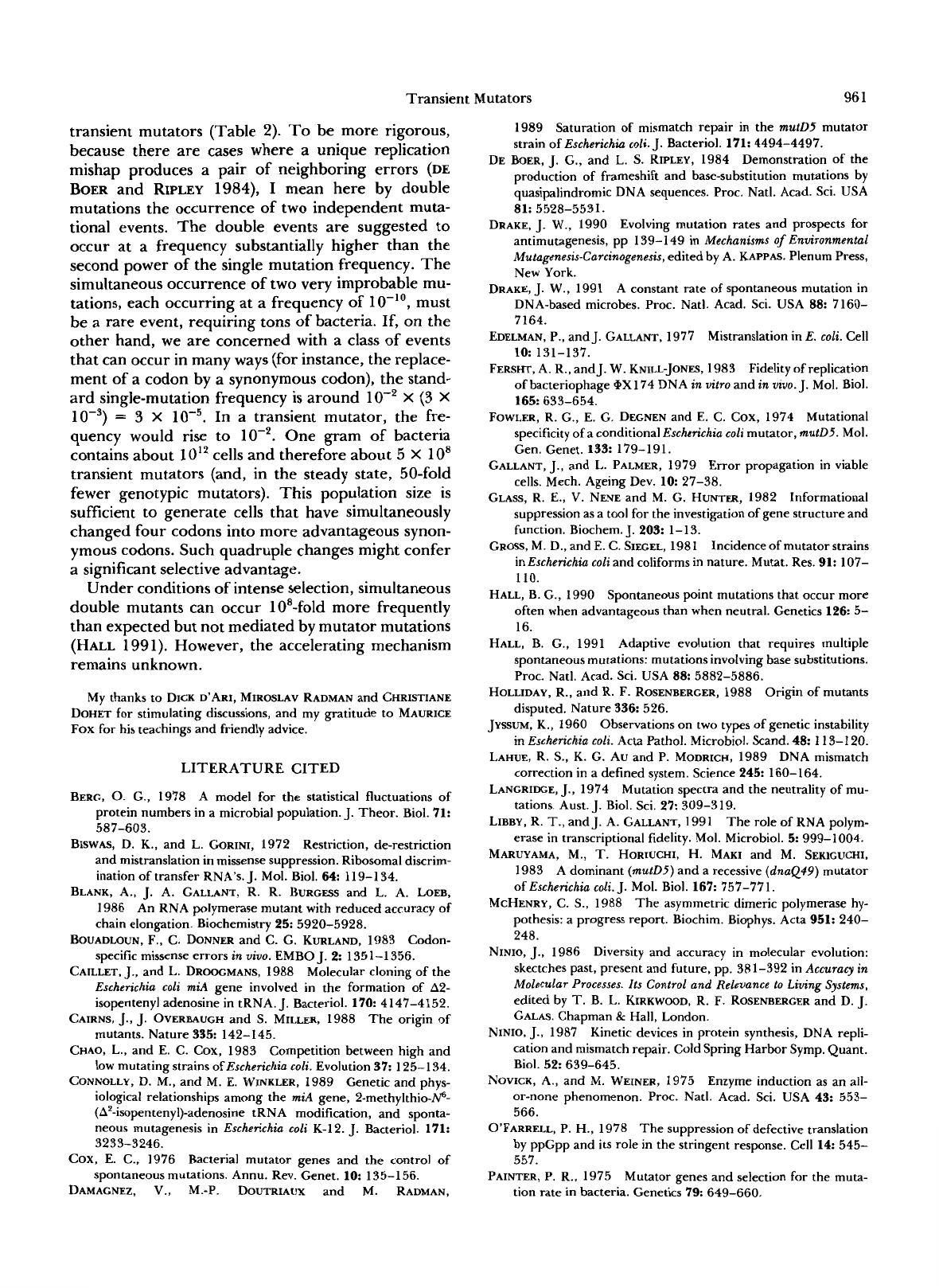
Transient
Mutators
96
1
transient mutators (Table
2).
To
be more rigorous,
because there are cases where a unique replication
mishap produces a pair of neighboring errors
(DE
BOER
and RIPLEY 1984),
I
mean here by double
mutations the occurrence of two independent muta-
tional events. The double events are suggested to
occur at a frequency substantially higher than the
second power of the single mutation frequency. The
simultaneous occurrence of two very improbable mu-
tations, each occurring at a frequency of must
be a rare event, requiring tons of bacteria. If, on the
other hand, we are concerned with a class of events
that can occur in many ways (for instance, the replace-
ment of a codon by a synonymous codon), the stand-
ard single-mutation frequency is around
lo-'
X
(3
X
1
0-3)
=
3
X
In a transient mutator, the fre-
quency would rise to
lo-'.
One gram of bacteria
contains about 10'' cells and therefore about
5
X
10'
transient mutators (and, in the steady state, 50-fold
fewer genotypic mutators).
This
population size
is
sufficient to generate cells that have simultaneously
changed four codons into more advantageous synon-
ymous codons. Such quadruple changes might confer
a
significant selective advantage.
Under conditions of intense selection, simultaneous
double mutants can occur lO*-fold more frequently
than expected but not mediated by mutator mutations
(HALL 1991). However, the accelerating mechanism
remains unknown.
My
thanks to DICK D'ARI,
MIROSLAV
RADMAN and CHRISTIANE
DOHET for stimulating discussions, and my gratitude to
MAURICE
FOX
for
his teachings and friendly advice.
LITERATURE CITED
BERG,
0.
G., 1978 A model for the statistical fluctuations of
protein numbers in a microbial population.
J.
Theor. Biol.
71:
BISWAS, D. K., and
L.
GORINI, 1972 Restriction, de-restriction
and mistranslation in missense suppression. Ribosomal discrim-
ination of transfer RNA's.
J.
Mol.
Biol.
64
119-134.
BLANK,
A.,
J.
A.
GALLANT, R. R. BURGESS and L. A. LOEB,
1986 An RNA polymerase mutant with reduced accuracy of
chain elongation. Biochemistry
25:
5920-5928.
BOUADLOUN, F., C. DONNER and C. G. KURLAND, 1983 Codon-
specific missense errors
in vivo.
EMBO
J.
2:
1351-1356.
CAILLET, J., and L. DROOGMANS, 1988 Molecular cloning of the
Escherichia coli miA
gene involved in the formation of 82-
isopentenyl adenosine in tRNA.
J.
Bacteriol.
170:
4147-4152.
CAIRNS,
J.,
J.
OVERBAUGH and
S.
MILLER, 1988 The origin of
mutants. Nature
335:
142-145.
CHAO, L., and E. C. COX, 1983 Competition between high and
low mutating strains
of
Escherichia coli.
Evolution
37:
125-134.
CONNOLLY,
D.
M.,
and
M.
E. WINKLER, 1989 Genetic and phys-
iological relationships among the
miA
gene, 2-methylthio-p-
(A'-isopentenyI)-adenosine
tRNA modification, and sponta-
neous mutagenesis in
Escherichia coli
K-12.
J.
Bacteriol.
171:
COX, E. C., 1976 Bacterial mutator genes and the control of
spontaneous mutations. Annu. Rev. Genet.
10
135-156.
587-603.
3233-3246.
DAMAGNEZ,
V.,
M.-P. DOUTRIAUX and
M.
RADMAN,
1989 Saturation of mismatch repair in the
mutD5
mutator
strain of
Escherichia
coli.
J.
Bacteriol.
171:
4494-4497.
DE BOER,
J.
G., and
L.
S.
RIPLEY, 1984 Demonstration of the
production
of
frameshift and base-substitution mutations by
quasipalindromic DNA sequences. Proc. Natl. Acad. Sci. USA
DRAKE,
J.
W., 1990 Evolving mutation rates and prospects for
antimutagenesis, pp 139-149 in
Mechanisms
of
Environmental
Mutagenesis-Carcinogenesis,
edited by A.
KAPPAS.
Plenum Press,
New York.
DRAKE,
J.
W.,
1991 A constant rate of spontaneous mutation in
DNA-based microbes. Proc. Natl. Acad. Sci. USA
88:
7160-
7164.
EDELMAN, P., and
J.
GALLANT, 1977 Mistranslation in
E. coli.
Cell
FERSHT,
A.
R., and
J.
W. KNILL-JONES, 1983 Fidelity of replication
of bacteriophage
ipX
174 DNA
in vitro
and
in vivo.
J.
Mol.
Biol.
165:
633-654.
FOWLER,
R.
G., E.
G.
DEGNEN and E.
C.
Cox, 1974 Mutational
specificity of a conditional
Escherichia coli
mutator,
mutD5.
Mol.
Gen. Genet.
133:
179-191.
GALLANT,
J.,
and
L.
PALMER, 1979 Error propagation in viable
cells. Mech. Ageing Dev.
10
27-38.
GLASS,
R.
E.,
V.
NENE and
M.
G. HUNTER, 1982 Informational
suppression as a tool for the investigation of gene structure and
function. Biochem.
J.
203:
1-13.
GROSS, M. D., and
E.
C. SIEGEL, 1981 Incidence of mutator strains
in
Escherichia coli
and coliforms in nature. Mutat. Res.
91:
107-
110.
HALL,
B.
G., 1990 Spontaneous point mutations that occur more
often when advantageous than when neutral. Genetics
126
5-
16.
HALL, B. G., 1991 Adaptive evolution that requires multiple
spontaneous mutations: mutations involving base substitutions.
Proc. Natl. Acad. Sci. USA
88:
5882-5886.
HOLLIDAY, R., and R. F. ROSENBERGER, 1988 Origin of mutants
disputed. Nature
336
526.
JYSSUM,
K.,
1960 Observations on two types of genetic instability
in
Escherichia
coli.
Acta Pathol. Microbiol. Scand.
48
1
13-1 20.
LAHUE, R.
S.,
K.
G. AU and
P.
MODRICH, 1989 DNA mismatch
correction in a defined system. Science
245:
160-164.
LANGRIDGE,
J.,
1974 Mutation spectra and the neutrality of mu-
tations. Aust.
J.
Biol. Sci.
27:
309-319.
LIBBY, R.
T.,
and
J.
A. GALLANT, 1991 The role of RNA polym-
erase in transcriptional fidelity. Mol. Microbiol.
5:
999-1004.
MARUYAMA, M.,
T.
HORIUCHI, H.
MAKI
and
M.
SEKIGUCHI,
1983 A dominant
(mutD5)
and a recessive
(dnaQ49)
mutator
ofEscherichia
coli.
J.
Mol.
Biol.
167:
757-771.
MCHENRY, C.
S.,
1988 The asymmetric dimeric polymerase hy-
pothesis: a progress report. Biochim. Biophys. Acta
951:
240-
248.
NINIO,
J.,
1986 Diversity and accuracy in molecular evolution:
skectches past, present and future, pp. 381-392 in
Accuracy in
Molecular Processes. Its Control and Relevance
to
Living Systems,
edited by
T.
B.
L.
KIRKWOOD, R.
F.
ROSENBERGER and D.
J.
GALAS. Chapman
&
Hall, London.
NINIO, J., 1987 Kinetic devices in protein synthesis, DNA repli-
cation and mismatch repair. Cold Spring Harbor Symp. Quant.
Biol.
52:
639-645.
NOVICK,
A.,
and
M.
WEINER, 1975 Enzyme induction as an
all-
or-none phenomenon. Proc. Natl. Acad. Sci. USA
43:
553-
566.
O'FARRELL,
P.
H., 1978 The suppression of defective translation
by ppGpp and its role in the stringent response. Cell
14:
545-
557.
PAINTER, P. R., 1975 Mutator genes and selection for the muta-
tion rate in bacteria. Genetics
79:
649-660.
81:
5528-5531.
10
131-137.
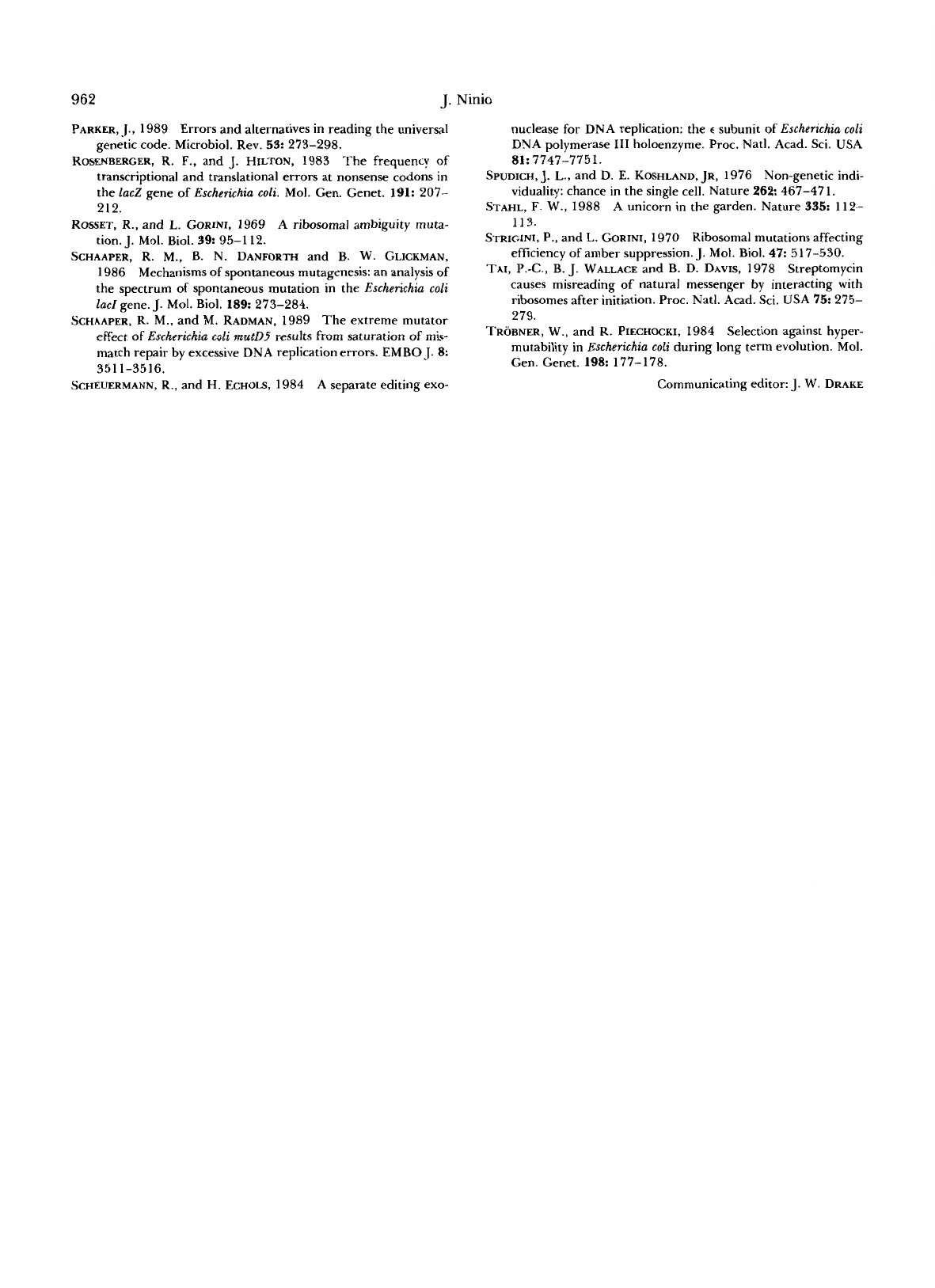
962
J.
Ninio
PARKER, J.,
1989
Errors
and alternatives in reading the universal
genetic code. Microbiol. Rev.
53:
273-298.
ROSENBERCER, R.
F.,
and
J.
HILTON,
1983
The frequency of
transcriptional and translational errors at nonsense codons in
the
lacZ
gene of
Escherichia coli.
Mol. Gen. Genet.
191:
207-
212.
ROSSET, R., and
L.
GORINI,
1969
A ribosomal ambiguity muta-
tion.
J.
Mol.
Biol.
39
95-1 12.
SCHAAPER,
R.
M.,
B. N.
DANFORTH
and
B.
W. GLICKMAN,
1986
Mechanisms of spontaneous mutagenesis: an analysis of
the spectrum of spontaneous mutation in the
Escherichia coli
lacl
gene.
J.
Mol. Biol.
189
273-284.
SCHAAPER,
R.
M.,
and
M.
RADMAN,
1989
The extreme mutator
effect of
Escherichia
coli
mutD5
results from saturation of mis-
match repair
by
excessive DNA replication errors. EMBO
J.
8:
SCHEUERMANN,
R., and
H.
ECHOLS,
1984
A separate editing exo-
351 1-3516.
nuclease for DNA replication: the
c
subunit of
Escherichia coli
DNA polymerase
111
holoenzyme. Proc. Natl. Acad. Sci. USA
SPUDICH, J.
L.,
and
D.
E.
KOSHLAND, JR,
1976
Non-genetic indi-
viduality: chance in the single cell. Nature
262:
467-47
1.
STAHL,
F.
W.,
1988 A
unicorn in the garden. Nature
335:
112-
113.
STRIGINI,
P., and
L.
GORINI,
1970
Ribosomal mutations affecting
efficiency of amber suppression.
J.
Mol.
Biol.
47: 5 17-530.
TAI,
P.-C.,
B.
J.
WALLACE
and
B.
D.
DAVIS,
1978
Streptomycin
causes misreading of natural messenger by interacting with
ribosomes after initiation. Proc. Natl. Acad. Sci. USA
75:
275-
279.
TROBNER,
W.,
and
R.
PIECHOCKI,
1984
Selection against hyper-
mutability in
Escherichia
coli
during long term evolution. Mol.
Gen. Genet.
198:
177-178.
81:
7747-7751.
Communicating editor:
J.
W. DRAKE
